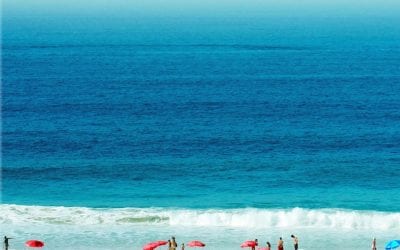
The cry goes out — orcas on right, 9 o’clock — and I tried desperately to spot a spout or tail or fin a mile and a half out. Still, it was the closest I’d ever come to a whale up to now, and I could be patient.
Looking around at my fellow passengers aboard the Orca Enterprises, a three-and-a half-hour whale-watching expedition in Juneau, Alaska, I realized that the idea of seeing a whale was almost as exciting as the actual viewing of a fin or part of the flank. Tourists look at an unidentifiable part in the blink of an eye — and it doesn’t dim their enthusiasm any. Still they shout out, “Wow, did you see that? It’s huge!”
Cameras and binoculars consistently point at where the whale just was in hopes of catching him there when he reappears, like paparazzi shooting a celebrity, but of course he’s moved — so the vigil starts again at the next fleeting exposure. And then, occasionally, one surfaces enough to actually confirm you’ve seen a whale — and you think, “Yes, now that’s what I’m talking about.”
 Captain Larry, whose beard extended almost to his navel and whose tall tales were almost as long as his beard, entertained us with seafaring trivia while naturalist and whale researcher Jack astounded us with whale-watching lore. And as an unexpected aside, the safety briefing included more detailed and amusing instructions on how to use the head than one usually is privy to, so to speak.
Captain Larry, whose beard extended almost to his navel and whose tall tales were almost as long as his beard, entertained us with seafaring trivia while naturalist and whale researcher Jack astounded us with whale-watching lore. And as an unexpected aside, the safety briefing included more detailed and amusing instructions on how to use the head than one usually is privy to, so to speak.
The orca or killer whale, we learned, is actually the world’s biggest dolphin. They are the social butterflies of the whale world and hang out together in family “pods”; the much larger, more independent Humpback tend to travel alone or in loose-knit groups. Unlike all their other ocean-dwelling neighbors, they don’t worry much about predators — their most feared stalker is Sea World.
I was beginning to feel a little frustration at the evasive nature of the orca. After all, this was called a whale-watching tour, not a whale-glimpsing one. Thank goodness for the humpbacks! Weighing in at the size of a large boat — as much as 50 feet long and tipping the scales at 40 tons — these babies can put on quite a show.
All we saw at first was a sliver of black. Then a wayward spiral of spray caught everyone’s attention. With experience, the eager onlookers recognized this as a prelude to an impressive denouement: the huge tail kicked up, wavered teasingly and then sleekly disappeared. Pandemonium broke out on deck; that alone made the whole trip worthwhile. The fact that this first-rate act continued to occur at about 8-minute intervals was just a bonus. It also made the humpback a lot more predictable than the orca and thus much easier to see, and cheer about.
Jack, who narrated much of the goings-on, clearly enjoyed what he was doing even after years of whale watching and research. He explained that many of the whales who visit Alaska every year hail from Maui, where they spend the winter. Smart whales. Also smart Jack, who winters there as well, studying the very same whales in both habitats. He identified the most active humpback as Flame, an old friend of his from Maui and the mother of four baby whales.
Now, the folks on my tour didn’t witness this particular activity but I understand that it is a frequent part of many whale-watching tours. The “bubble-netting” feeding technique is used by humpback whales who gather together and blow air through their air-holes in order to herd schools of small fish into a tight ball through which the whales then plunge. Rumor has it it’s quite a feat, and feast, to watch!
Another rumor states that the most spectacular whale-watching experience in Alaska is the annual gray whale migration. Every year, some 20,000 gray whales make their way from their winter hideaways to the cold-water feeding grounds of the Bering Sea. From the end of March until early May, these giant transient visitors can be easily observed from a variety of whale watching cruises, large and small. Something to look forward to on my next trip.
 But whales were not the sole attraction on this expedition. Bald eagles in Alaska are as plentiful as pigeons in New York but that doesn’t diminish their majesty in flight. Stellar sea lions, the largest of the seal populace, can be seen lounging on the rocks along the shoreline, bleating and bellowing so loud as to drown out the boat’s very noisy motor. Then attention diverted to harbor seals, several dozen of which were swimming along the shore, their heads bobbing in the water like little brown, slippery Jacks in the Box. They, however, were a lot less enamored of the whales than we were, as the orcas are their most common predator. And so story and nature come full-circle: both the harbor seals and I were watching the whales closely, but for very different reasons.
But whales were not the sole attraction on this expedition. Bald eagles in Alaska are as plentiful as pigeons in New York but that doesn’t diminish their majesty in flight. Stellar sea lions, the largest of the seal populace, can be seen lounging on the rocks along the shoreline, bleating and bellowing so loud as to drown out the boat’s very noisy motor. Then attention diverted to harbor seals, several dozen of which were swimming along the shore, their heads bobbing in the water like little brown, slippery Jacks in the Box. They, however, were a lot less enamored of the whales than we were, as the orcas are their most common predator. And so story and nature come full-circle: both the harbor seals and I were watching the whales closely, but for very different reasons.
For more information, visit www.alaskawhalewatching.com; the price for the 3- ½-hour tour is $120 per adult, $57, child.

Fyllis Hockman is a multi-award-winning travel journalist who has been traveling and writing for over 30 years — and is still as eager for the next trip as she was for the first. Her articles appear in newspapers across the country and websites across the internet. When not traveling, she is almost as happy watching plays or movies, working out and sitting on a barstool next to her travel-writing husband.



